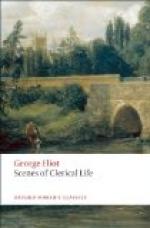Such were the things that Martha had dusted and let the air upon, four times a-year, ever since she was a blooming lass of twenty; and she was now, in this last decade of Mr. Gilfil’s life, unquestionably on the wrong side of fifty. Such was the locked-up chamber in Mr. Gilfil’s house: a sort of visible symbol of the secret chamber in his heart, where he had long turned the key on early hopes and early sorrows, shutting up for ever all the passion and the poetry of his life.
There were not many people in the parish, besides Martha, who had any very distinct remembrance of Mr. Gilfil’s wife, or indeed who knew anything of her, beyond the fact that there was a marble tablet, with a Latin inscription in memory of her, over the vicarage pew. The parishioners who were old enough to remember her arrival were not generally gifted with descriptive powers, and the utmost you could gather from them was, that Mrs. Gilfil looked like a ‘furriner, wi’ such eyes, you can’t think, an’ a voice as went through you when she sung at church.’ The one exception was Mrs. Patten, whose strong memory and taste for personal narrative made her a great source of oral tradition in Shepperton. Mr. Hackit, who had not come into the parish until ten years after Mrs. Gilfil’s death, would often put old questions to Mrs. Patten for the sake of getting the old answers, which pleased him in the same way as passages from a favourite book, or the scenes of a familiar play, please more accomplished people.
’Ah, you remember well the Sunday as Mrs. Gilfil first come to church, eh, Mrs. Patten?’
’To be sure I do. It was a fine bright Sunday as ever was seen, just at the beginnin’ o’ hay harvest. Mr. Tarbett preached that day, and Mr. Gilfil sat i’ the pew with his wife. I think I see him now, a-leading her up the aisle, an’ her head not reachin’ much above his elber: a little pale woman, with eyes as black as sloes, an’ yet lookin’ blank-like, as if she see’d nothing with ’em.’




